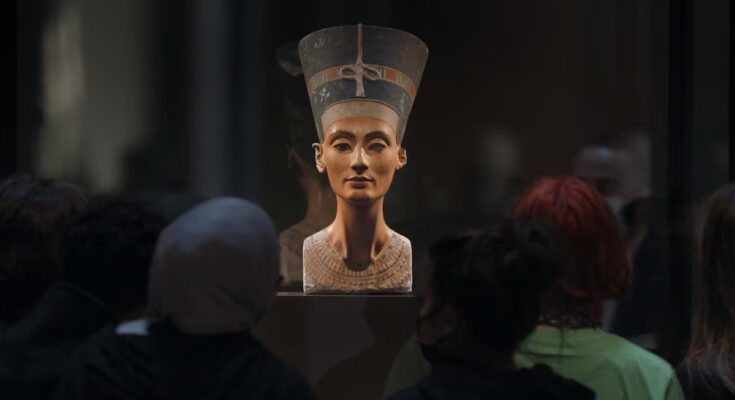Egypt has every moral right to recover its emblematic works from the Pharaonic era that foreign museums possess. And naturally the opening of the splendid Grand Egyptian Museum (GEM) is a good opportunity to push for the restitution of those cultural and artistic treasures, at the head of which is the triad (and the Egyptological similarity is valid) Nefertiti-Rosetta-Dendera. These are the bust of Queen Nefertiti from the sculptor Thutmose’s workshop in Amarna, the Hellenistic stele with a decree in three scriptures known as the Rosetta Stone and which was used to decipher the hieroglyphics and the bas-relief with an astronomical map called the Dendera Zodiac and torn from the ceiling of a room in the temple of the goddess Hathor in that town on the banks of the Nile, 60 kilometers north of Luxor.
Nefertiti is in the Neues Museum in Berlin, the stone in a very busy room in the British Museum and the Zodiac in the Louvre, which represents the ancient colonial powers and their predation very well. The celestial representation and the stele came from Egypt more or less as a consequence of Napoleon’s campaign in the country: the Zodiac was drawn by one of Bonaparte’s sages taken in that adventure, Vivian Denon, and the publication of his engravings in 1802 aroused so much interest that in 1820 the work was extracted in a rather brutal way, saws and gunpowder included, and sent to Paris; The stone was recovered by the French in a Mamluk fort near Rosetta where it had been used as a building material, but it was finally taken by the English in 1801, after defeating Napoleon’s troops. In the case of Nefertiti, the bust turned up apparently more legally, following the agreed division of the finds from Ludwig Borchardt’s Amarna expedition, although it seems quite clear that the piece was retained by the Germans in a ruse to disguise its exceptional nature.
The Zodiac is a work little known to the general public and therefore its representativeness in the fight for its antiquities that Egypt is renewing is much lower than that of the other two (also it should be considered whether it would be necessary to return it to the temple of Dendera from where it was taken). The Rosetta Stone, which the English do not think of returning at all, is much more emblematic and holds the history of its use to decipher hieroglyphics, i.e. a value that most people understand and appreciate, although the stele itself – essentially, for the layman, a stone covered in signs – is not an artistic work but rather a document. Nefertiti, and has always been prized as such, actually plays in a different division: she is one of humanity’s greatest artistic expressions, an enduring symbol of beauty, and an exceptional sculpture. There are few aesthetic and vital experiences like standing in front of the queen’s bust. One can imagine the light that would radiate into a GEM room and the anticipation it would inspire. Together with Tutankhamun’s mask, it would show in a fabulous union of stucco and gold the sum of the highest achievements of the pharaonic civilization.
Being able to contemplate two similar wonders in the same visit, and with the pyramids of Giza in view, would be an extraordinary attraction for the new museum and it is logical that Egypt considers the bust essential and inalienable. But it is unlikely that, if things do not change much, she will leave Berlin, where a museum has been practically tailor-made for her (the Neues gravitates towards the face of the queen, her star) and the idea has permeated that after so many years Nefertiti is already another Berliner, with a history full of vicissitudes, such as the Second World War, much more dramatic than those of the centuries spent buried under the sand of the sculpture workshop of the old and abandoned capital of Akhenaten. It is known that Hitler did not particularly appreciate it (his type was Eva Braun) and was willing to exchange it for other works.
Nefertiti means “the beautiful one has arrived” but it doesn’t seem that the name should sound prescient for the Egyptians at the moment, no matter how much enthusiasm they put into it. It is also true that in its current location the queen (accompanied by other sensational Amarnian portraits from the same workshop which, among other things, Zahi Hawass does not seem to claim) plays a leading role in stimulating interest in Ancient Egypt and in inviting visitors to visit the Nile Country, increasing tourism, one of the reasons that motivated, let’s not forget, the creation of the GEM. In this sense, all Egyptian collections present in European museums (and in the rest of the world) behave in the same way, and the Egyptian authorities know this well.

The movement now for the return of emblematic antiquities (the obelisks could be included in a very strict list) is similar to the pressure that was sought to be brought to bear for the return of the Elgin Marbles when the new Acropolis Museum opened in 2009, with empty spaces designed directly to accommodate the pieces exhibited by the British Museum. The inauguration did not achieve this goal (although it did return fragments of the Parthenon held by other museums).
The inauguration of the GEM allowed the return of some works, but the major triad remains immovable. Meanwhile, the new museum displays a never-before-seen collection (including mummies, which is another topic) and it may take some time to reach its goals opera masterpieces, the masterpieces he aspires to, but the rooms are already filled with tourists.


